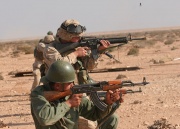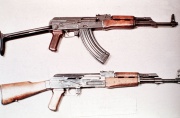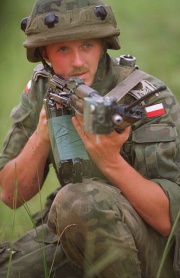AKM
| |||||||||||||||||||||||||||||||||||||||||||||||||||||||
The AKM (Russian: Автомат Калашникова Модернизированный; Avtomat Kalashnikova Modernizirovanniy or "automatic rifle Kalashnikov modernized") is a 7.62 mm assault rifle designed by Mikhail Kalashnikov. It is an upgraded version of the AK-47 rifle and was developed in the 1950s. Introduced into service with the Red Army in 1959, the AKM is the most ubiquitous variant of the entire AK series of firearms and it has found widespread use with most member states of the former Warsaw Pact and its many African and Asian allies. The production of Soviet rifles was carried out at both the Tula Arsenal and Izhevsk Mechanical Works. It was replaced by the AK-74 in the late 70s.
Contents |
[edit] Design details
Compared to the AK-47, the AKM features enhancements that optimized the rifle for mass production, some parts and assemblies were also conceived using simplified manufacturing methods. As a result of these modifications, the AKM’s weight was reduced by approx. 1 kg, the accuracy was increased and several reliability issues were addressed.
The AKM’s receiver, compared to the AK-47, has a stamped sheet metal housing to which a rear stock trunnion and forward barrel trunnion are fastened using rivets. The receiver housing also features a rigid tubular cross-section support that adds structural strength. Guide rails that assist the bolt carrier’s movement which also includes the ejector are installed inside the receiver through spot welding.
The forward barrel trunnion has a non-threaded socket where the barrel is embedded and a hole for a pin that secures the barrel in place. On some models the rear trunnion has two extended mounting arms on both sides that support the buttstock, other fixed models use a stepped shaped trunnion that that covers the full width of the inside of the receiver.
The stamped dust cover contains both longitudinal and latitudinal reinforcing ribs for increased durability and decrease weight because of the use of thinner sheet metal
The AKM’s barrel is installed in the forward trunnion and pinned (as opposed to the AK-47, which has a one piece receiver with trunnions that are not removable and a barrel that is screwed-in). Additionally the barrel has horizontal guide slots that help align and secure the handguards in place. To increase the weapon’s accuracy during rapid fire, the AKM was fitted with a slant cut muzzle brake that helps redirect expanding propellant gases upward and to the left during firing. The muzzle brake is threaded on to the end of the barrel.
The AKM also has a modified trigger assembly, equipped with a hammer-release delaying device (installed on the same axis pin together with the trigger and disconnector). This device reduces "trigger slap" or "trigger bounce" and the weapon’s rate of fire, which also reduces the dispersion of bullets when firing in fully-automatic mode. The hammer was also changed and equipped with a protrusion that engages the rate reducer and the trigger has only one notched hammer release arm (compared to two parallel arms in the AK-47).
The gas block in the AKM does not have a cleaning rod capture or sling loop but is instead fitted with an integrated bayonet support collar that has a cleaning rod guide hole. The forward sling loop was relocated to the front handguard retainer cap, the handguard retainer also has notches that determine the position of the handguards on the barrel. The AKM’s laminated wood handguards have lateral grooves that help securely grip the rifle.
Gas relief ports that alleviate gas pressure in the piston cylinder (placed horizontally in a row on the gas cylinder in the AK-47) were moved forward to the gas block and placed in a radial arrangement.
The AKM’s bolt carrier is slightly lighter in weight and despite some minor differences in its shape – it can be used interchangeably with the AK-47’s bolt carrier and bolt.
The wooden stock used in the AKM is further hollowed in order to reduce weight and is different in shape to a small degree.
The AKM uses a modified return spring mechanism, which replaces the single recoil spring guide rod with a dual “U”-shaped wire guide.
The AKM’s rear sight consists of a ramp with a range scale marked from 100 to 1,000 m (graduated every 100 m), as compared to that of the original AK-47, which was graduated to 800 meters. The rear sight leaf’s position teeth that secure the sliding adjustable notch were transferred over from the right to the left edge of the ramp. The front sight post also has a slightly different shape and its bottom portion is more narrow.
The AKM comes supplied with a different accessory kit that contains a M1959 6H4 or 6H3-type bayonet (that forms a wire-cutting device when coupled with its scabbard) and comes with synthetic or alloy magazines. The kit also comes with a punch used to drive out various pins and a device that aids in assembling the rate retarding mechanism.
The AKM uses the same ammunition as the AK-47: the 7.62x39mm M43 intermediate rifle cartridge. The arrangement of mechanisms and parts in the AKM and their interaction during loading and firing is practically identical to AK-47, the only difference being the trigger assembly (during the return stage of the bolt carrier on fully automatic mode) as a result of incorporating the rate reducer device.
[edit] Variants
The main variant of the AKM is the AKMS (S – So skladnym prikladom), which was equipped with an under-folding metal shoulder stock in place of the fixed wooden stock. The metal stock of the AKMS is somewhat different from the folding stock of the previous AK-47 model as it has a modified locking mechanism, which locks both support arms of the AKMS stock instead of just one (left arm) as in the AK-47 folding model.
The AKM was produced in the following versions: AKMP, AKML and AKMLP, whereas the AKMS led to the following models – AKMSN, AKMSP and AKMSNP.
The AKMP rifle uses subdued tritium-illuminated aiming points integrated into the front and rear sight. These sights enable targets to be engaged in low-level light conditions, i.e. when the battlefield is illuminated with flares, fires or muzzle flashes or when the target is visible as a shadow against an illuminated background. The sliding notch on the sight arm is then moved to the “S” setting (which corresponds to the “3” setting in the AKM). The sight itself is guided on the sliding scale and has a socket, which contains a tritium gas-filled capsule directly beneath the day-time notch. The tritium front post installs into the front sight base using a detent and spring.
The AKML comes equipped with a side-rail used to attach a night vision device. The mount comprises a flat plate riveted to the left wall of the receiver housing and a support bracket fixed to the mounting base with screws. To shield the light-sensitive photo detector plate of the night vision sight, the weapon uses a slotted flash suppressor, which replaces the standard recoil compensator. The AKML can also be deployed in the prone position with a detachable barrel-mounted bipod that helps stabilize the weapon and reduces operator fatigue during prolonged periods of observation. The bipod is supplied as an accessory and is carried in a holster attached to the duty belt.
The AKMLP is a version of the AKML with tritium sights (as in the AKMP).
The AKMSP rifle is based on the folding stock AKMS variant but fitted with tritium night sights, as in the AKMP.
The AKMSN model is derived from the AKMS and features an accessory rail used to mount a night vision sensor as seen on the AKML and additionally a flash hider and bipod. The left arm of the AKMSN’s folding stock is bent outwards in order to avoid the sight mount bracket during folding and the sling loop was moved further to the rear.
A version of the AKMSN additionally supplied with factory tritium night sights is called the AKMSNP.
A version of the AKM with a modified lower handguard designed to accept the 40 mm wz. 1974 Pallad grenade launcher was developed in Poland and designated the karabinek-granatnik wz. 1974.
[edit] Users
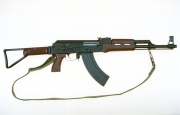
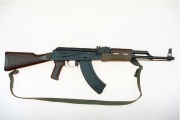
- Albania
- Afghanistan
- Algeria
- Angola
- Bangladesh
- Belarus
- Bulgaria
- Cambodia
- Central African Republic
- Pakistan
- PRC: Manufactured by Norinco as the Type 56.
- Comoros
- Democratic Republic of the Congo
- Republic of the Congo
- Cuba
- East Germany: Manufactured by the state arsenal as the MPi-KM (fixed stock) and MPi-KMS-72 (AKMS).
- Egypt: The Misr is an Egyptian copy of the AKM, manufactured by Factory 54 of the Maadi Company for Engineering Industries in Cairo for the Egyptian Army and for export sales. Also produced in a semi-automatic version known as the ARM which is sold as a sporting firearm to the civilian and law enforcement markets. The standard Misr rifle has a wooden forward handguard and buttstock while the pistol grip and upper handguard are plastic. The word Misr (مصر) means "Egypt" in Arabic. The Maadi variants in various guises have been imported into the US as modified sporting variants in significant numbers. AK variants have been manufactured in Egypt shortly after the period the country aligned itself with the Soviet Union. The differences between the AKMS and the Misr are the use a different folding stock, the use of plastic for the handguard and pistol grip rather than wood and a modified upper receiver that accepts most US and NATO optics. The military version, used by Egyptian forces in the 1991 Gulf War, was a very high quality clone of the AKM with a side folding stock, chrome-plated bore and either 30-round box or 75-round drum magazine.[1][2][3][4]
- Equatorial Guinea
- Finland: Holds stocks of imported AKM clones for reserve service (the Chinese Type 56 known as the RK 56 TP[5] and the East German MPi-KM as the RK 72[6]) along with locally designed AK derivatives (the RK 62 and the RK 95 TP) for its active units.
- Hungary: Locally manufactured by the state arms plant FÉG as the AK-63 or AMMS in current Hungarian military service. This is a conventional AKM clone which replaced the earlier AKM-63, which was similar but had a modified handguard. A model with a side-folding stock was also made as the AMD-65, or Automata Módosított Deszantfegyver ("automatic modified descent weapon"). A rare carbine variant with a proprietary side-rail optic mount was also introduced, designated AMP-69.
- Iraq
- Laos
- Mali
- Moldova
- Morocco
- North Korea: Type 68.
- Poland: Accepted into service with the Polish Armed Forces in 1956 as the karabinek AKM. Produced locally at the Łucznik Arms Factory since 1966. Currently being replaced by the kbk wz. 96 Beryl rifle.
- Romania: Built locally as the PM md. 63, PM md. 65, PM md. 90 under the umbrella name AIM. Almost identical to the Soviet AKM with the exception of the handguard, which features a vertical front grip.
- Russia Is still in use by some Russian special forces, and by some regular troops, more as apersonal choice, due to the 7.62x39s ability to penetrate cover and walls effectively compared to small-caliber, high-velocity cartridges.
- Rwanda: Uses the Egyptian-made Misr variant of the AKM.
- Soviet Union
- Suriname
- Ukraine
- Vietnam
- Yugoslavia: Several variants based on the AKM built by Zastava Arms factory, most notably the M70 and M70B.
- Zimbabwe
[edit] Resources
The Gun Owners' Resource online library has the following documents available for free download for the AKM rifle and its variants:
- Hungarian AKM Instruction and Safety Manual - published by Kassnar Arms (22 page .PDF file, 4.3MB)

This article is either missing some diagrams which would help to illustrate a proper breakdown of the firearm in question or the diagrams which are here are inadequate. This article could use more input to fill in the missing bits. You (yes, you!) can help Gunsopedia provide more comprehensive information to our users by using your own knowledge to add to it.
[edit] References
- ↑ Maadi Company for Engineering Industries (Factory 54), fas.org
- ↑ Maadi Company for Engineering Industries (Factory 54) , GlobalSecurity.org
- ↑ AK Exhibits Page 16
- ↑ Egyptian Rifles
- ↑ 7.62 RK 56 TP / 7.62 rynnäkkökivääri 56 TP mil.fi
- ↑ 7.62 RK 72 / 7.62 rynnäkkökivääri 72 mil.fi
[edit] See also
| "AKM" is part of a series on the AK-47 and its cousins |
|---|


